Chinese Handwriting Recognition: An Algorithmic Perspective
Nonfiction, Computers, Advanced Computing, Engineering, Computer Vision, Application Software, Computer Graphics, General Computing| Author: | Tonghua Su | ISBN: | 9783642318122 |
| Publisher: | Springer Berlin Heidelberg | Publication: | January 11, 2013 |
| Imprint: | Springer | Language: | English |
| Author: | Tonghua Su |
| ISBN: | 9783642318122 |
| Publisher: | Springer Berlin Heidelberg |
| Publication: | January 11, 2013 |
| Imprint: | Springer |
| Language: | English |
Designing machines that can read handwriting like human beings has been an ambitious goal for more than half a century, driving talented researchers to explore diverse approaches. Obstacles have often been encountered that at first appeared insurmountable but were indeed overcome before long. Yet some open issues remain to be solved. As an indispensable branch, Chinese handwriting recognition has been termed as one of the most difficult Pattern Recognition tasks. Chinese handwriting recognition poses its own unique challenges, such as huge variations in strokes, diversity of writing styles, and a large set of confusable categories. With ever-increasing training data, researchers have pursued elaborate algorithms to discern characters from different categories and compensate for the sample variations within the same category. As a result, Chinese handwriting recognition has evolved substantially and amazing achievements can be seen. This book introduces integral algorithms used in Chinese handwriting recognition and the applications of Chinese handwriting recogniers. The first part of the book covers both widespread canonical algorithms to a reliable recognizer and newly developed scalable methods in Chinese handwriting recognition. The recognition of Chinese handwritten text is presented systematically, including instructive guidelines for collecting samples, novel recognition paradigms, distributed discriminative learning of appearance models and distributed estimation of contextual models for large categories, in addition to celebrated methods, e.g. Gradient features, MQDF and HMMs. In the second part of this book, endeavors are made to create a friendlier human-machine interface through application of Chinese handwriting recognition. Four scenarios are exemplified: grid-assisted input, shortest moving input, handwritten micro-blog, and instant handwriting messenger. All the while, the book moves from basic to more complex approaches, also providing a list for further reading with literature comments.
Designing machines that can read handwriting like human beings has been an ambitious goal for more than half a century, driving talented researchers to explore diverse approaches. Obstacles have often been encountered that at first appeared insurmountable but were indeed overcome before long. Yet some open issues remain to be solved. As an indispensable branch, Chinese handwriting recognition has been termed as one of the most difficult Pattern Recognition tasks. Chinese handwriting recognition poses its own unique challenges, such as huge variations in strokes, diversity of writing styles, and a large set of confusable categories. With ever-increasing training data, researchers have pursued elaborate algorithms to discern characters from different categories and compensate for the sample variations within the same category. As a result, Chinese handwriting recognition has evolved substantially and amazing achievements can be seen. This book introduces integral algorithms used in Chinese handwriting recognition and the applications of Chinese handwriting recogniers. The first part of the book covers both widespread canonical algorithms to a reliable recognizer and newly developed scalable methods in Chinese handwriting recognition. The recognition of Chinese handwritten text is presented systematically, including instructive guidelines for collecting samples, novel recognition paradigms, distributed discriminative learning of appearance models and distributed estimation of contextual models for large categories, in addition to celebrated methods, e.g. Gradient features, MQDF and HMMs. In the second part of this book, endeavors are made to create a friendlier human-machine interface through application of Chinese handwriting recognition. Four scenarios are exemplified: grid-assisted input, shortest moving input, handwritten micro-blog, and instant handwriting messenger. All the while, the book moves from basic to more complex approaches, also providing a list for further reading with literature comments.















